Bhaktapur
Bhaktapur (Nepali: भक्तपुर, pronounced [ˈbʱʌkt̪ʌpur] (![]()
Bhaktapur भक्तपुर Khwopa | |
|---|---|
Town | |
 Bhaktapur Durbar Square before the 2015 earthquake | |
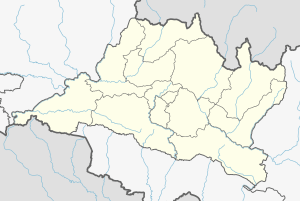 Bhaktapur Location in Nepal 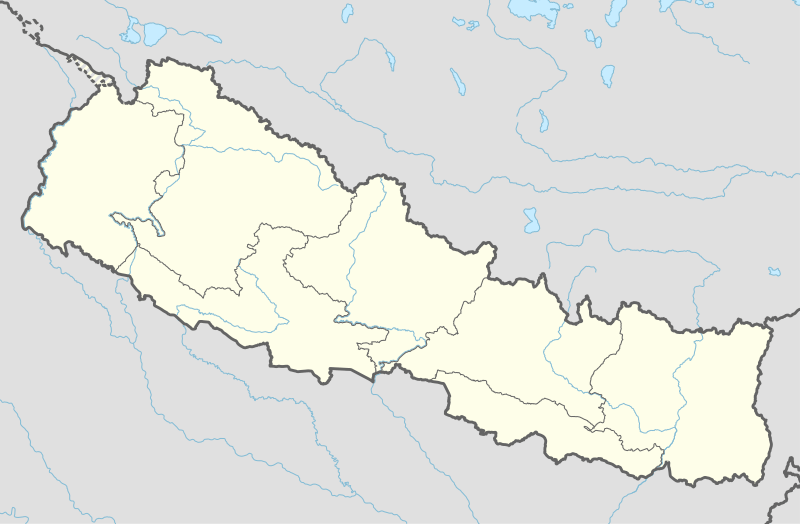 Bhaktapur Bhaktapur (Nepal) | |
| Coordinates: 27°40′20″N 85°25′40″E | |
| Country | Nepal |
| Province | Bagmati Pradesh |
| District | Bhaktapur |
| Government | |
| • Mayor | Sunil Prajapati (NWPP) |
| • Deputy Mayor | Rajani Joshi (NWPP) |
| Area | |
| • Total | 16.89 km2 (6.52 sq mi) |
| Population (2011) | |
| • Total | 81,728 |
| • Density | 4,800/km2 (13,000/sq mi) |
| • Religions | Hinduism, Buddhism |
| Time zone | UTCUTC+05:45 (NST) |
| Postal code | 44800 |
| Area code(s) | 01 |
| Website | http://bhaktapurmun.gov.np |
| Wikimedia Commons has media related to Bhaktapur. |
Khwopa was the largest of the three Newa kingdoms of the Kathmandu Valley and was the capital of Nepal during the great 'Malla Kingdom' until the second half of the 15th century. It has a population of more than 81,728, of which the vast majority are still Newa Nepa mi. Historically more isolated than the other two kingdoms, Kathmandu and Patan, Bhaktapur has a distinctly different form of Nepal Bhasa language.
Bhaktapur has the best-preserved palace courtyards and old city centre in Nepal and is listed as a World Heritage Site by UNESCO for its rich culture, temples, and wood, metal and stone artworks. This is supported by the restoration and preservation efforts of the German-funded Bhaktapur Development Project (BDP).
The city is famous for a special type of dahi (yoghurt) called "Ju Ju(king) dhau(curd).
History
It is the home of traditional art and architecture, historical monuments and craftwork, magnificent windows, pottery and weaving industries, excellent temples, beautiful ponds, rich local customs, culture, religion, festivals, musical mystic and so on. Bhaktapur is still an untouched as well as preserved ancient city that is itself the world to explore for tourists.here are so many heritage Sites to view our ancient history.
From time immemorial it lay on the trade route between Tibet and India. This position on the main caravan route made the town rich and prosperous.
Demographics
At the time of the 2001 Nepal census, it had a population of 72,543.[1] The male inhabitants of this city wear a special type of cap called the Bhadgaunle Topi, Daura Suruwal whereas the female wears Hakupatashi and Whantang Suruwal. it is the cultural dresses of newar community that they wear from their ancient times.newar community people were easily recognized from their dresses and their language.
Landmarks

Layaku (Durbar Square)
Bhaktapur Durbar Square is a conglomeration of pagoda and shikhara-style temples, mostly dedicated to Hindu gods and goddesses grouped around a 55-window palace of brick and wood. The square is one of the most charming architectural showpieces of the valley as it highlights the ancient arts of Nepal. The golden effigies of the kings perched on the top of stone monoliths, the guardian deities looking out from their sanctuaries, the wood carvings in every place — struts, lintels, uprights, tympanums, gateways and windows — all seem to form a well-orchestrated symphony.[2]
The royal palace was originally situated at Dattaraya square and was only later moved to the Durbar Square location. The square in Bhaktapur was severely damaged by an earthquake in 1934 and hence appears more spacious than the ones at Kathmandu and Patan.
Nyatapola Temple
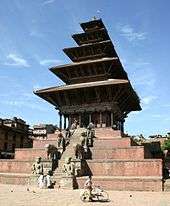
Nyatapola Temple is a 5-story pagoda style temple located in Bhaktapur, Nepal. The temple was erected by Nepali King Bhupatindra Malla during a 5-month period from late 1701 to 1702. It is the temple of Siddha Laxmi, the Hindu goddess of prosperity. Its foundation is said to be wider than the temple's base. [2]
Bhairab Nath Temple
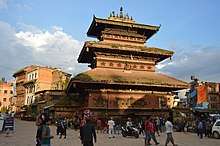
This is another pagoda temple of lord Bhairab, the dreadful aspect of Lord Shiva. It stands near the Nyatapola temple and was originally constructed by King Jagat Jyoti Malla on a modest scale. It was later remodelled by King Bhupatindra Malla, a zealous lover of the arts, into what it is now a three-storeyed temple.[2]
Dattatraya Temple
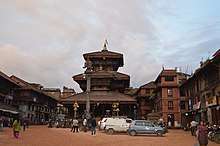
The temple of Dattatraya is as old as the Palace of Fifty-five Windows. The three-story pagoda-style Dattatraya Temple, with statues of the Hindu trinity, (Brahma the creator, Vishnu the preserver, and Shiva the destroyer), was built during the reign of King Yaksha Malla (1428 A.D. – 1482 A.D.) and was opened to the public around 1486 A.D., only after his demise. The exact date of construction of the Dattatraya temple is still obscure. This temple, according to popular belief, was constructed from a single piece of wood from one tree. At the entrance are two large sculptures of the Jaiput wrestlers, Jaimala and Pata (as in the Nyatapola Temple), a "Chakra", and a gilded metal statue of Garuda, a bird-like divinity. Around the temple are wood carved panels with erotic decorations. It was subsequently repaired and renovated by King Vishwa Malla in 1548 A.D.[2]
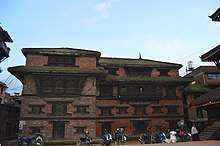
Just beside temple is a monastery (Math) with exquisitely carved peacock windows. These famous windows were carved during the reign of King Vishwa Malla. The monastery is full of artistic facades of latticed windows and engraved columns.[2]
Changu Narayan
Changu Narayan is an ancient Hindu temple located near the village of Changunarayan in the Kathmandu Valley on top of a hill at the eastern end of the valley. It is 6 kilometres (3.7 mi) to the north of Bhakathapur and 22 kilometres (14 mi) from Kathmandu. The temple is one of the oldest Hindu temples of the valley and is believed to have been constructed first in the 4th century. Changu Narayan is the name of Vishnu, and the temple is dedicated to him. A stone slab discovered in the vicinity of the temple dates to the 5th century and is the oldest such stone inscription discovered in Nepal. It was rebuilt after the old temple was devastated. Many of the stone sculptures date to the Licchavi period. Changu Narayan Temple is listed by UNESCO[3] as a World Heritage Site.[4][5]
The temple is a double-roofed structure where the idol of Lord Vishnu in his incarnation as Narayana is deified. The temple has intricate roof struts showing multi-armed Tantric deities. A kneeling image of Garuda (dated to the 5th century), the vahana or vehicle of Vishnu with a snake around its neck, faces the temple. The gilded door depicts stone lions guarding the temple. Gilded windows also flank the door. A conch and a disc, symbols of Vishnu, are carved on the two pillars at the entrance. Non-Hindus are not allowed inside the temple.[5]
Ta Pukhu (Siddha Pokhari)
%2C_built_during_the_reign_of_King_Yakshya_Malla_in_the_early_15th_century%2C_Bhaktapur.jpg)
Ta Pukhu (Siddha Pokhari) is a big rectangular water pond near the main city gate. It was built during the reign of King Yakshya Malla in the early 15th century and is associated with a number of myths. From this spot a wide range of snowy peaks are visible on clear days.[2]
Kailashnath Mahadev Statue
Kailashnath Mahadev is the World's Tallest Lord Shiva statue. The height of this statue is 143 feet high and is situated 20 km from Kathmandu, Nepal. The statues construction work was started in 2004 and was completed in 2012. The statue's inauguration took place on 21 June 2012. This statue stands on the 32nd position in the list of all statues by height in the world. It has been made of copper, cement, zinc and steel. To make this gigantic structure possible there were many professional workers and statue makers from India.
Festivals
Bhaktapur is also known as the city of festivals and celebrations. The city celebrates festivals each month starting from new year festival to the Holi puni at the end of the year.
- Bisket Jatra (Biska Jatra - New year festival)
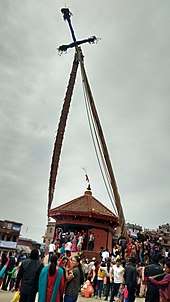
This ancient annual festival of Bhaktapur takes place at the New Year of the Bikram Sambat calendar. A few days before the New Year, usually at Chaitra 27 or Chaitra 28, if 31 days in month.., the goddess 'bhadrakali' and the god 'bhairab' are enshrined in their raths, or immense chariots,& pulled through the narrow streets of Bhaktapur by crowds of young men.
The chariots rest at certain time-honored places in the city and people come out to throw offerings of flower, rice, coins and red sindur powder. On the last day of the old year a towering wooden pole is known as ' lyesing dha: or lingo 'is erected at the edge of town. Long banners hang from the pole, symbolising snakes...Nag and Nagini. On New Year's Day, the erected pole is brought down symbolizing victory over evil, People enjoy New year day along with a victory over evils. On Baisakh 5, the chariot is again pulled to the narrow street of Bhaktapur and brought to its origin place, Taumadhi square marking the end of Bisket Jatra.
- Kumar Khasti (Sithi Nakha)
Before modern piping system, wells and kuwas were the basis for water supply in Bhaktapur. On this day, people clean wells and worship Naag favouring good fall in monsoon. They celebrate by eating delicious delicacies like bara and chatamari.
- Gathamaga charya
Gathamaga is made of straw that symbols a devil. Local make gathamaga in their locality and burn fire to remove devils of their locality. It is also said that mosquito loses its one leg in this day.
- Sa: Paaru (Gai Jatra)
The celebration of Gai Jatra Bhaktapur is interesting among Kathmandu and Lalitpur. On this day, Tall bamboo poles wrapped in cloth and topped horn of straw and an umbrella is carried around the town in memory of dead. The photo of the dead is hung in this pole called Ta macha.
Also, A colourful procession known as Ghing tang gishi is the main attraction of this festival. People decorate themselves with masks and paints.
Gunla is the name of the 10th month of Nepal Era calendar. It is sacred month dedicated to Lord Buddha celebrated in Kathmandu, Patan and Bhaktapur
But In Bhaktapur, Last day of Gunla Panchadan is celebrated differently. The Five Buddhas are brought to Taumadhi square accompanied with Gunla Baja, a special musical instrument played only in Gunla and Buddhas are rounded around Bhaktapur town
- Pulu Kisi (Indra Jatra)
The son of Lord of heaven is believed to have been kidnapped by a devil named Maisasur who then tied Indra's son in a pole and killed. Indra was shocked to hear his son's death and sent an elephant, pulukisi to find and kill Maisasur. But legend says Pulukisi couldn't find maisur till date. This Jatra is a play to that legendary story where pulu kisi is rounded around the town to search for Maisasur.
- Sithi Nakha
In Bhaktapur, a palanquin with an image of the Hindu goddess Bhagwati is carried in colourful procession through Nyatapol square this day.
- Dhanya Purnima (Yomari Purnima)
In this day Farmers of Kathmandu valley worship to Annapurna, the Goddess of grains.l for good rice harvest and enjoy a feast after all the hard work of the season.Yomari is the chief item on the menu in this day. So is called Yomari Puni.
- Maghe sankranti (Ghya-chaku sankranti) (Makar Sankranti)
This festival marks the winter solstice and Newars partake of a feast. The days special. The menu includes butter (ghyu), molasses (chaku) and yam.
In Bhaktapur, On this auspicious day samyak Dan is performed by Buddhist. The shakyas and Bajracharya gather in a samyak ground near Napukhu pond accompanied with panchabuddhas and samyak buddhas. They are offered chaku balls and rice. Bhaktapur is the only one in the valley that conducts samyak Dan once in a year.
- Shree Panchami
People regard this day as a propitious day for starting a new enterprise. Devotee throng Devi shrine to seek blessing. In Bhaktapur, People visit Sashwo:dega in this auspicious day where the idol of Buddhist deity Mahamanjushree is kept. Hindus regard it as Saraswati and worship whereas Buddhist worship it as Manjushree.
In popular culture
Portions of the Hollywood film Little Buddha starring Keanu Reeves and Bridget Fonda were filmed in the Bhaktapur Durbar Square. Also, portions of Indian films Hare Rama Hare Krishna and Baby were shot in Bhaktapur.[6]
2015 earthquake
The Magnitude 7.8 2015 Nepal earthquake that struck on 25 April 2015 (12 Baisakh 2072 B.S., Saturday, at local time 11:56 am) damaged 116 heritages in the city. Of them, 67 were completely damaged while 49 suffered from partial damages. The quake has badly damaged the Durbar square, a significant heritage site included in the UNESCO world heritage list. The main premises of Taleju Temple here also witnessed damages in the disaster.
The Nepal–Bihar earthquake in 1934 demolished several buildings that were never rebuilt. Chyasilin Mandap has been rebuilt.[7]
See also
Gallery
 Street of Bhaktapur at night
Street of Bhaktapur at night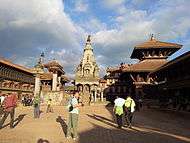 Bhaktapur Durbar Square
Bhaktapur Durbar Square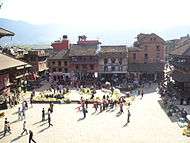 Bhaktapur Taumadhi square.
Bhaktapur Taumadhi square. Statue of King Bhupatindra Malla at Bhaktapur Durbar Square
Statue of King Bhupatindra Malla at Bhaktapur Durbar Square- View of Taumadhi square
- Peacock Window
- Temple of Nyatapola
 Woman drying rice
Woman drying rice- Newari king curd (Juju Dhau)
- Bhaktapur Durbar Square
- Nyatapola Temple
.jpg) Festival preparations
Festival preparations
2015 after 7.8 magnitudes earthquake photo gallery
 Bhaktapur Durbar Square Under construction after April 25, 2015 earthquake
Bhaktapur Durbar Square Under construction after April 25, 2015 earthquake Waiting for renovation a Dhunge Dhara (Stone Tap) in Changunarayan Temple
Waiting for renovation a Dhunge Dhara (Stone Tap) in Changunarayan Temple After a massive earthquake in 2015 (7.8 magnitude) several parts of Changunarayan Temple were damaged
After a massive earthquake in 2015 (7.8 magnitude) several parts of Changunarayan Temple were damaged After a massive earthquake in 2015 (7.8 magnitude) the main door of Changunarayan Temple were damaged part
After a massive earthquake in 2015 (7.8 magnitude) the main door of Changunarayan Temple were damaged part After a massive earthquake in 2015 (7.8 magnitude) around Changunarayan Temple praying with Diyo light
After a massive earthquake in 2015 (7.8 magnitude) around Changunarayan Temple praying with Diyo light After a massive earthquake in 2015 (7.8 magnitude) several parts of Changunarayan Temple were damaged a stone statu of Narayan lying down
After a massive earthquake in 2015 (7.8 magnitude) several parts of Changunarayan Temple were damaged a stone statu of Narayan lying down After a massive earthquake in 2015 (7.8 magnitude) several parts of Changunarayan Temple were damaged from south side of temple
After a massive earthquake in 2015 (7.8 magnitude) several parts of Changunarayan Temple were damaged from south side of temple After a massive earthquake in 2015 (7.8 magnitude) several parts of Changunarayan Temple were damaged from west side of temple
After a massive earthquake in 2015 (7.8 magnitude) several parts of Changunarayan Temple were damaged from west side of temple
References
- City Population . Retrieved: 9 Dec, 2011.
- Destination Nepal: Bhaktapur . Retrieved: 9 Dec, 2011.
- Vajracharya, Gautam (2003), "Bhaktapur", Oxford Art Online, Oxford University Press, doi:10.1093/gao/9781884446054.article.t008588
- "UNESCO".
- "Introducing Changu Narayan Temple". Retrieved 2009-12-19.
- http://www.filmapia.com/films/movies/b/baby
- The Eight Cornered Gift, Oct.15.2014, Kapil Bisht
- Bindloss, Joe; Holden, Trent; Mayhew, Bradley. (2009). Nepal. Lonely Planet.
- Destination Nepal: Bhaktapur, Retrieved: 9 Dec, 2011
- https://web.archive.org/web/20150716231329/http://www.ekantipur.com/2015/05/08/capital/april-25-quake-damages-116-heritages-in-bhaktapur/404994.html
Retrieved: 8 May 2015
- http://www.bhaktapur.com/
- http://himalaya.socanth.cam.ac.uk/collections/journals/ancientnepal/pdf/ancient_nepal_106_01.pdf
Further reading
- Bijukchhe, N.M. 2059 VS (2002/3 AD). Saya Barsha Pachiko Bhaktapur (Bhaktapur After 100 Years). Bhaktapur: Kendriya Prakashan Samiti, Nepal Majdur Kishan Party.
- Dhakal, Suresh, and Sanjeev Pokharel. 2009. "Local Movements, Political Processes and Transformation: A Case Study of Bhaktapur Municipality." Occasional Papers in Sociology and Anthropology 11:178-201.
- Gellner, David. 2001. The Anthropology of Hinduism and Buddhism: Weberian Themes. New Delhi: Oxford University Press. (Chap. 12 and 13.)
- Gibson, Ian. 2015. Suffering and Christianity: Conversion and Ethical Change Among the Newars of Bhaktapur. D.Phil. Thesis in Anthropology, University of Oxford. (Especially chap. 2-4.)
- Gibson, Ian. 2017. Suffering and Hope: Christianity and Ethics among the Newars of Bhaktapur. Kathmandu: Ekta Books.
- Grieve, Gregory. 2006. Retheorizing religion in Nepal. New York: Palgrave Macmillan.
- Gutschow, Niels, and Bernhard Kolver. 1975. Ordered space: concepts and functions in a town of Nepal. Wiesbaden: Kommissionsverlag Franz Steiner.
- Gutschow, Niels, and Axel Michaels. 2005. Handling death: the dynamics of death and ancestor rituals among the Newars of Bhaktapur, Nepal. Wiesbaden: Harrassowitz.
- Gutschow, Niels, and Axel Michaels. 2008. Growing up: Hindu and Buddhist initiation rituals among Newar children in Bhaktapur, Nepal. Wiesbaden: Harrassowitz.
- Gutschow, Niels, and Axel Michaels. 2012. Getting married: Hindu and Buddhist marriage rituals among the Newars of Bhaktapur and Patan, Nepal. Wiesbaden: Harrassowitz.
- Haaland, Ane. 1982. Bhaktapur, A Town Changing. Analysis of a development project’s influence on social change in a medieval society in Nepal.
- Hachhethu, Krishna. 2007. Social Change and Leadership: A Case Study of Bhaktapur City. In Political and social transformations in north India and Nepal, edited by Hiroshi Ishii, David Gellner and Katsuo Nawa. New Delhi: Manohar.
- Levy, Robert. 1990. Mesocosm: Hinduism and the Organization of a Traditional Newar city in Nepal. Berkeley: University of California Press.
- Mikesell, Stephen L. 1993. "A Critique of Levy's theory of the urban mesocosm." Contributions to Nepalese studies 20 (2):231-54.
- Parish, Steven M. 1994. Moral knowing in a Hindu sacred city: an exploration of mind, emotion, and self. New York: Columbia University Press.
- Parish, Steven M. 1996. Hierarchy and its discontents: culture and the politics of consciousness in caste society. Philadelphia: University of Pennsylvania Press.
- Raj, Yogesh. 2010. History as mindscapes: a memory of the peasants' movement of Nepal. Kathmandu: Martin Chautari.
- Widdess, Richard. 2013. Dāphā: sacred singing in a South Asian city: music, performance and meaning in Bhaktapur, Nepal. Farnham: Ashgate.
- von Schroeder, Ulrich. 2019. Nepalese Stone Sculptures. Volume One: Hindu; Volume Two: Buddhist. (Visual Dharma Publications, 2019). 1556 pages with 2960 illustrations (duo-tone with numerous colour illustrations); 345 x 240 mm; bound with slipcase. Includes glossary, bibliography, chronological table, and index. SD card with more than 15,000 digital photos. ISBN 9783033063815
External links
| Wikimedia Commons has media related to Bhaktapur. |

- Old pictures of Bhaktapur from 1920
- Explore Nepal: Bhaktapur
- Bhaktapur Photo gallery
- After quake situation of Nepal's cultural capital, Bhaktapur, ABP News, Apr 29, 2015
- Tourist captures terrifying moment earthquake strikes Bhaktapur, Leon Siciliano, video source APTN6:25PM BST 30 Apr 2015
